- Home
- Chimney Guide
- Wood Stove Chimney
Installing A Wood Stove Chimney
This post may contain affiliate links so I earn a commission.
Often neglected, ignored, or misunderstood, a wood stove chimney is the backbone that supports your wood burning stove.
Think of it as the "behind the scenes" workhorse that drives the entire wood burning system.
Although it's exciting to focus on the most efficient stove or the latest technology, it's easy to forget your stove will only function as well as the chimney it connects to.
The majority of the problems, such as back puffing, poor draft, or the smell of soot in the house, can be traced back to a poorly constructed chimney.
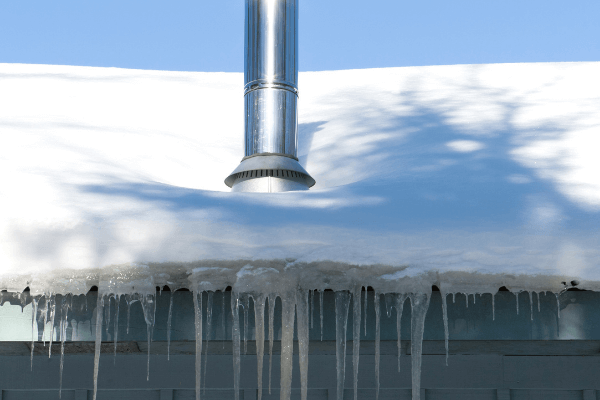
Proper venting is crucial for a functional and efficient wood burning stove.
As you consider venting, you will find various options.
So, where do you start?
To learn more, let us look at how a chimney operates and why its design is important.
Draft In A Chimney
For a wood burning stove to function properly, the chimney must expel hot gases up and out of the home.
As the gases rise up the chimney, it creates a pressure difference that allows the stove to draw in fresh air used for combustion – kind of like a vacuum.
This movement of gases up the chimney is known as draft.
The temperature of the gases inside the chimney and the overall chimney height both play an important factor in determining draft.
For example, the hotter the gases are inside the chimney compared to the temperature of the outside air, the stronger the draft will be.
Also, the taller the chimney, the more draft it will create.
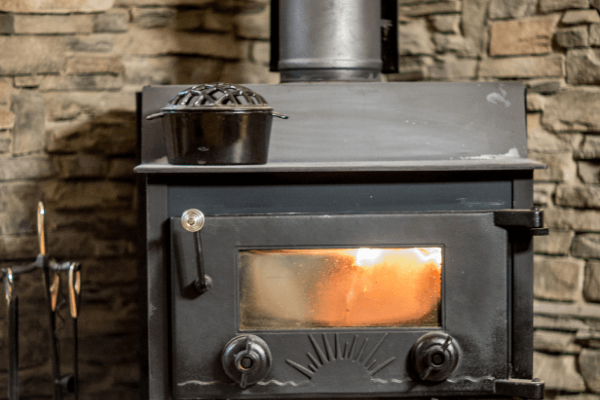
Outside air currents that form around trees, buildings, or roof peaks can create problems that reduce and interfere with draft.
To prevent this from occurring, a chimney should extend at least 3 feet past a flat roof and be at least 2 feet above any roof peak within a 10-foot radius.
In general, the chimney’s overall height from the base of the wood stove to the top of the chimney should not be less than 15 feet.
Wood Stove Chimney - Inside Vs. Outside
Contrary to popular belief, chimneys that exit the home at ground level and run outside along the exterior walls of the home are extremely inefficient.
Since hot air rises, the outside temperatures cool the gases inside the chimney, reducing draft.
These cooling gases can also create condensation and a buildup of creosote.
Creosote forms when warm gases come into contact with a cold surface, which is what happens when you run a chimney outside.
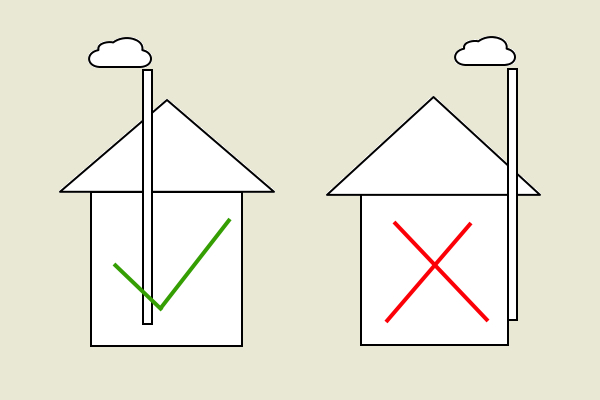
By locating the stove in the center of your home, the wood stove chimney will extend straight up through the living quarters of your home, where the temperature is warm.
The warm temperatures surrounding the chimney keep the flue gases warm, which helps create a strong draft.
Plus, the chimney exits near the roof peak.
This eliminates the possibility of unwanted problems caused by outside structures.
Other Ways To Increase Draft
Besides installing an interior chimney, you should also make sure the chimney flue size matches the requirements of your stove.
For example, a flue that is too small can create too much draft, and a flue that is too large will have decreased pressure resulting in a reduction in draft.
The stove manufacturer will have a recommendation for which size of chimney flue you should install for optimal performance.
Typically the flue collar on the stove will determine your chimney flue size.
Limit the number of bends in the chimney by reducing excessive T's or elbows and try to avoid long horizontal runs in the chimney.
Think of a chimney as a dryer vent.
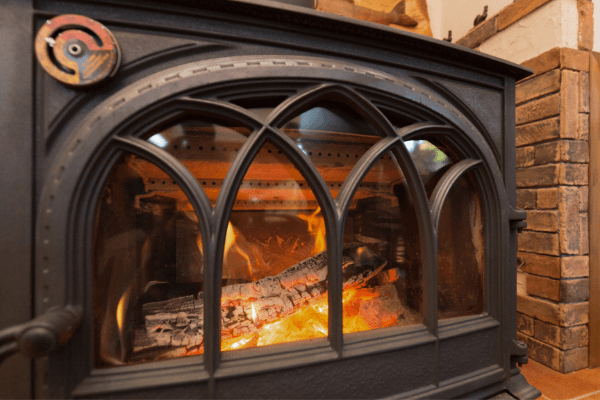
The more the dryer vent bends and zigzags, the more lint it collects inside the pipe.
A chimney is the same way; only the lint is actually creosote.
A straight, vertical path without restrictions will create a strong draft.
Most wood stove manufacturers rate their equipment to accept only a few venting systems.
That makes it less intimidating to choose from the wide variety of options available.
However, there are several things to consider, ensuring the best functioning of your unit.
Venting Categories For Your Wood Stove Chimney
Wood stove venting has two main categories:
- Air-cooled chimney systems
- Insulated chimneys
Air-cooled chimney systems use air for cooling.
They have a space between the chimney walls to allow air from outside to move freely.
Since air is not as good in insulation as solid materials, air-cooled chimney systems are usually big.
Their design allows for at least 2 inches of airspace between each chimney wall layer.
Insulated chimneys have a layer of solid insulation between the outer and inner chimney walls.
Normally, the insulation consists of fiberglass, mineral wool, or a ceramic blanket.
If your wood burning stove burns at extremely
high temperatures, an insulated chimney is a good idea to maintain safe
temperatures in your home.
Wood Stove Chimney Design Phase
Before buying your chimney, you must consider the amount of venting you require.
First, recognize any special conditions you might have. Next, find out which venting is approved by your local code.
Manufacturers offer a comprehensive list of venting circumstances in the user manual.
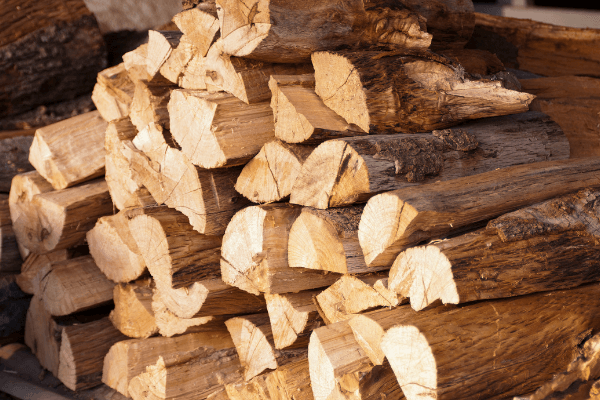
It is disappointing to find out that your preferred wood
stove is not allowed in your location.
However, there might be other suitable options.
So, you should do your research before purchasing a new appliance to avoid an expensive mistake.
Understanding the blueprints of your home is also crucial in determining the dimensions of your chimney.
A technician can help you create a comprehensive
list of venting constituents you will need for your specific application.
Wood Stove Chimney Chase
If situated within a safe enclosure within your home, chimney systems for wood burning stoves can be channeled through the ceiling.
Another way to route your chimney is to use a chimney chase or envelope secured to the exterior of your home.
A chimney chase is a popular choice - the structures house your entire chimney system without sacrificing space.
Although they are expensive, chimney chases are the most effective options if you want to preserve floor space.
The base of your chimney chase must fit the framing dimensions of your wood stove.
Test Your Chimney System
After completing your installation, you should test your chimney system to ensure it works correctly.
You should test for leakage and draw.
Build a small fire in your wood stove and inspect all the areas of your venting system.
Look for any condensation drips and smoke leaks and address the problems.
Overall
Wood stove chimney installation can be challenging for a beginner.
Therefore, it is recommended that you work with an experienced chimney technician.
This will help you adhere to the code and height regulations.
It is also a good idea to insulate the chimney chase before enclosing.
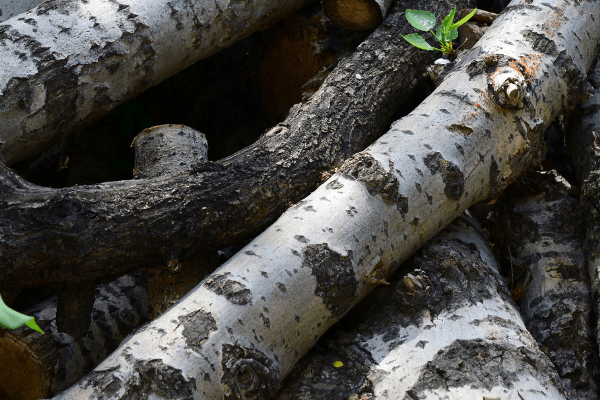
That helps in preventing large temperature variations and
poor performance of your wood stove.
So what's the best way to install a wood stove chimney inside your home?
Remember these basic principles:
- Install the stove in the center of your home with the chimney running straight up through the warm part of your house.
- Limit the number of bends in the chimney, and make sure to use an insulated high-temperature pipe.
- Match the flue size to the flue collar on the stove.
- A tall chimney is a happy chimney.
Remember, the chimney is the backbone of your wood burning stove.
Inspect it regularly for damage caused by high temperatures, moisture, or corrosion.
Also, have the wood stove chimney inspected and cleaned by
a certified professional at least once a year to maintain your investment and,
more importantly, increase your safety.

About the Author
Obsessed with firewood, Nick is behind over 350+ of Firewood For Life's articles, as well as countless reviews, guides and YouTube videos to help readers like you reduce heating costs and create the perfect fire.


